MNC Profitability: A Case Study of Nestle's Declining Revenue
VerifiedAdded on 2020/05/16
|18
|3748
|258
Report
AI Summary
This report examines the issue of declining profits in multinational corporations (MNCs), specifically focusing on Nestle, the world's largest food manufacturer. Despite increasing sales and global presence, Nestle faces dwindling profits, leading to weakened capital generation, a decline in competitive strength, and a loss of stakeholder support. The report details a project plan designed to address these issues, including PESTLE, Porter's model, and SWOT analyses, along with marketing and product strategies. The project aims to identify profitable business units, divest from unprofitable segments, acquire new subsidiaries, and introduce innovative products. The methodology involves quantitative, qualitative, and mixed methods. The report highlights project highlights, potential setbacks, and anticipated outcomes, including increased profits, enhanced capital generation, and regained competitive strength. The report provides recommendations for Nestle, including new product strategies and strategic acquisitions to overcome these challenges.
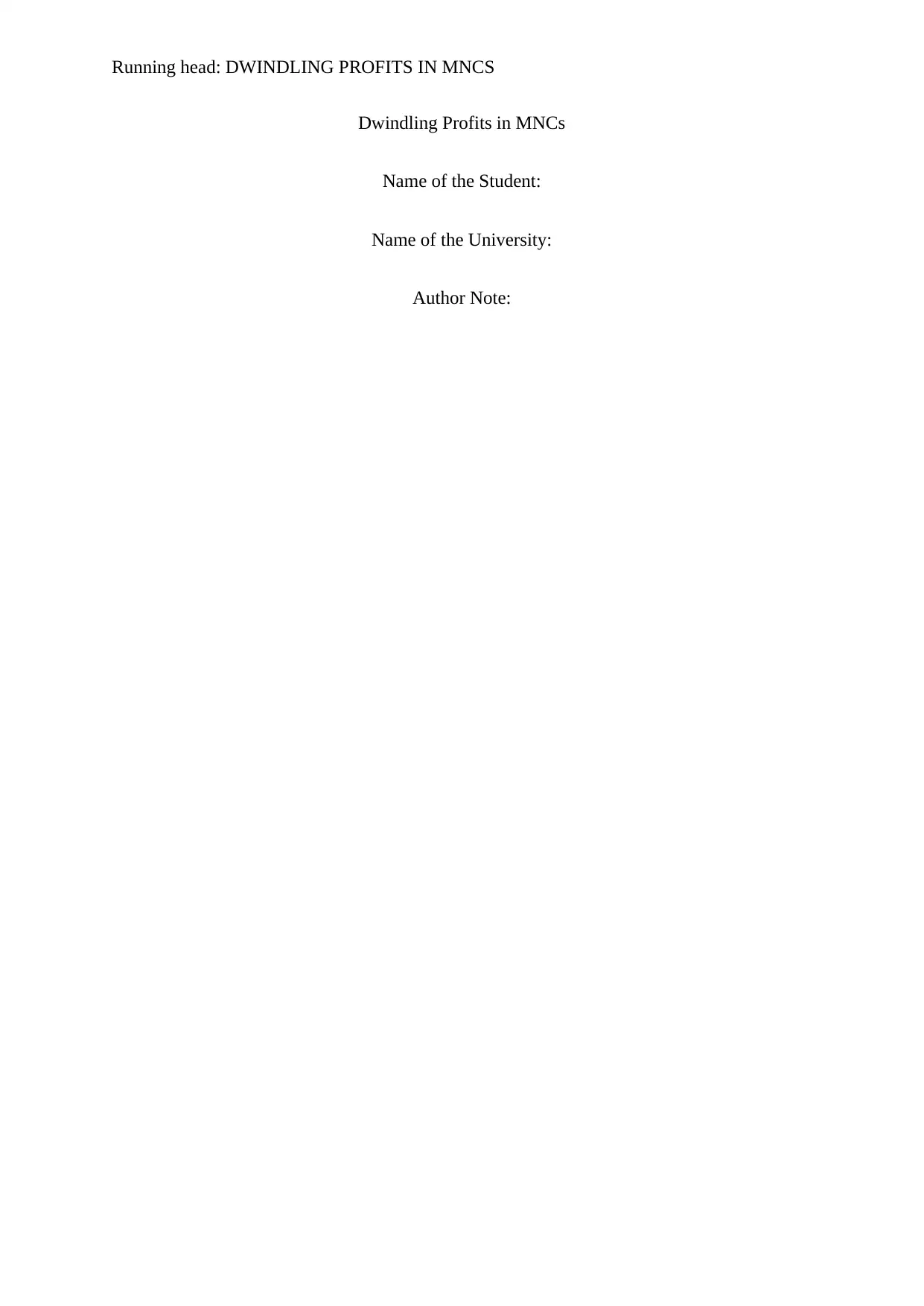
Running head: DWINDLING PROFITS IN MNCS
Dwindling Profits in MNCs
Name of the Student:
Name of the University:
Author Note:
Dwindling Profits in MNCs
Name of the Student:
Name of the University:
Author Note:
Paraphrase This Document
Need a fresh take? Get an instant paraphrase of this document with our AI Paraphraser
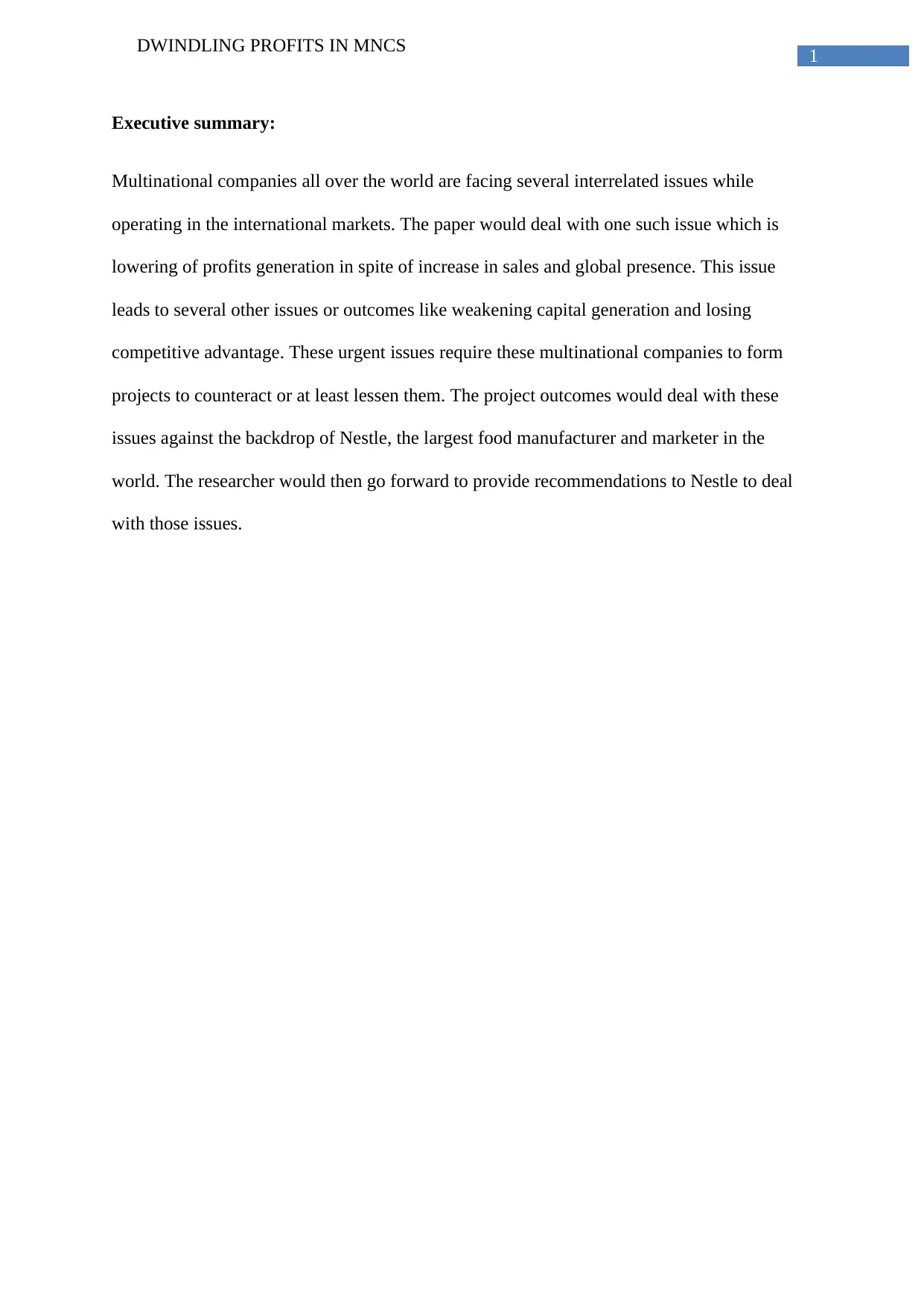
1
DWINDLING PROFITS IN MNCS
Executive summary:
Multinational companies all over the world are facing several interrelated issues while
operating in the international markets. The paper would deal with one such issue which is
lowering of profits generation in spite of increase in sales and global presence. This issue
leads to several other issues or outcomes like weakening capital generation and losing
competitive advantage. These urgent issues require these multinational companies to form
projects to counteract or at least lessen them. The project outcomes would deal with these
issues against the backdrop of Nestle, the largest food manufacturer and marketer in the
world. The researcher would then go forward to provide recommendations to Nestle to deal
with those issues.
DWINDLING PROFITS IN MNCS
Executive summary:
Multinational companies all over the world are facing several interrelated issues while
operating in the international markets. The paper would deal with one such issue which is
lowering of profits generation in spite of increase in sales and global presence. This issue
leads to several other issues or outcomes like weakening capital generation and losing
competitive advantage. These urgent issues require these multinational companies to form
projects to counteract or at least lessen them. The project outcomes would deal with these
issues against the backdrop of Nestle, the largest food manufacturer and marketer in the
world. The researcher would then go forward to provide recommendations to Nestle to deal
with those issues.
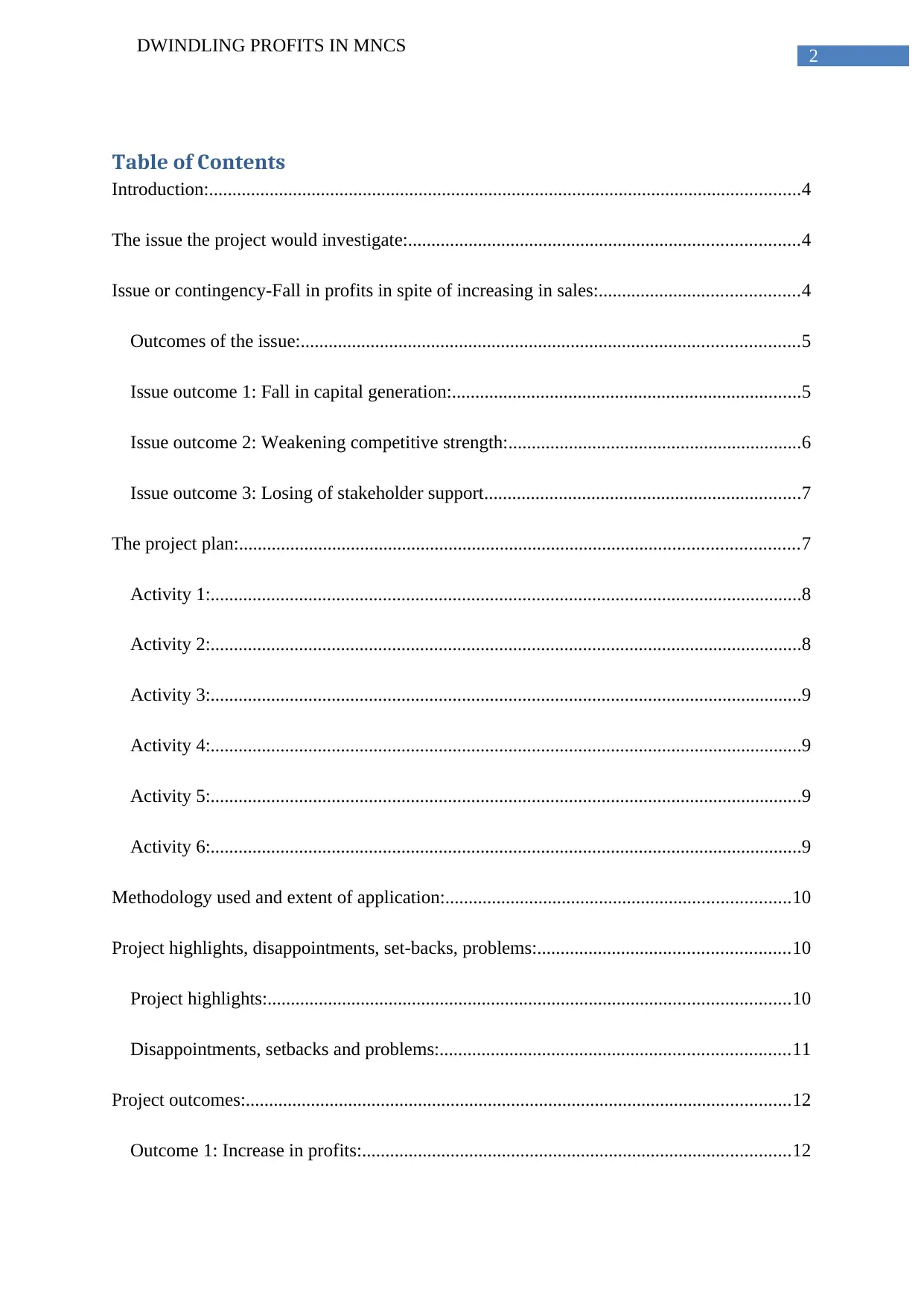
2
DWINDLING PROFITS IN MNCS
Table of Contents
Introduction:...............................................................................................................................4
The issue the project would investigate:....................................................................................4
Issue or contingency-Fall in profits in spite of increasing in sales:...........................................4
Outcomes of the issue:...........................................................................................................5
Issue outcome 1: Fall in capital generation:...........................................................................5
Issue outcome 2: Weakening competitive strength:...............................................................6
Issue outcome 3: Losing of stakeholder support....................................................................7
The project plan:........................................................................................................................7
Activity 1:...............................................................................................................................8
Activity 2:...............................................................................................................................8
Activity 3:...............................................................................................................................9
Activity 4:...............................................................................................................................9
Activity 5:...............................................................................................................................9
Activity 6:...............................................................................................................................9
Methodology used and extent of application:..........................................................................10
Project highlights, disappointments, set-backs, problems:......................................................10
Project highlights:................................................................................................................10
Disappointments, setbacks and problems:...........................................................................11
Project outcomes:.....................................................................................................................12
Outcome 1: Increase in profits:............................................................................................12
DWINDLING PROFITS IN MNCS
Table of Contents
Introduction:...............................................................................................................................4
The issue the project would investigate:....................................................................................4
Issue or contingency-Fall in profits in spite of increasing in sales:...........................................4
Outcomes of the issue:...........................................................................................................5
Issue outcome 1: Fall in capital generation:...........................................................................5
Issue outcome 2: Weakening competitive strength:...............................................................6
Issue outcome 3: Losing of stakeholder support....................................................................7
The project plan:........................................................................................................................7
Activity 1:...............................................................................................................................8
Activity 2:...............................................................................................................................8
Activity 3:...............................................................................................................................9
Activity 4:...............................................................................................................................9
Activity 5:...............................................................................................................................9
Activity 6:...............................................................................................................................9
Methodology used and extent of application:..........................................................................10
Project highlights, disappointments, set-backs, problems:......................................................10
Project highlights:................................................................................................................10
Disappointments, setbacks and problems:...........................................................................11
Project outcomes:.....................................................................................................................12
Outcome 1: Increase in profits:............................................................................................12
⊘ This is a preview!⊘
Do you want full access?
Subscribe today to unlock all pages.

Trusted by 1+ million students worldwide
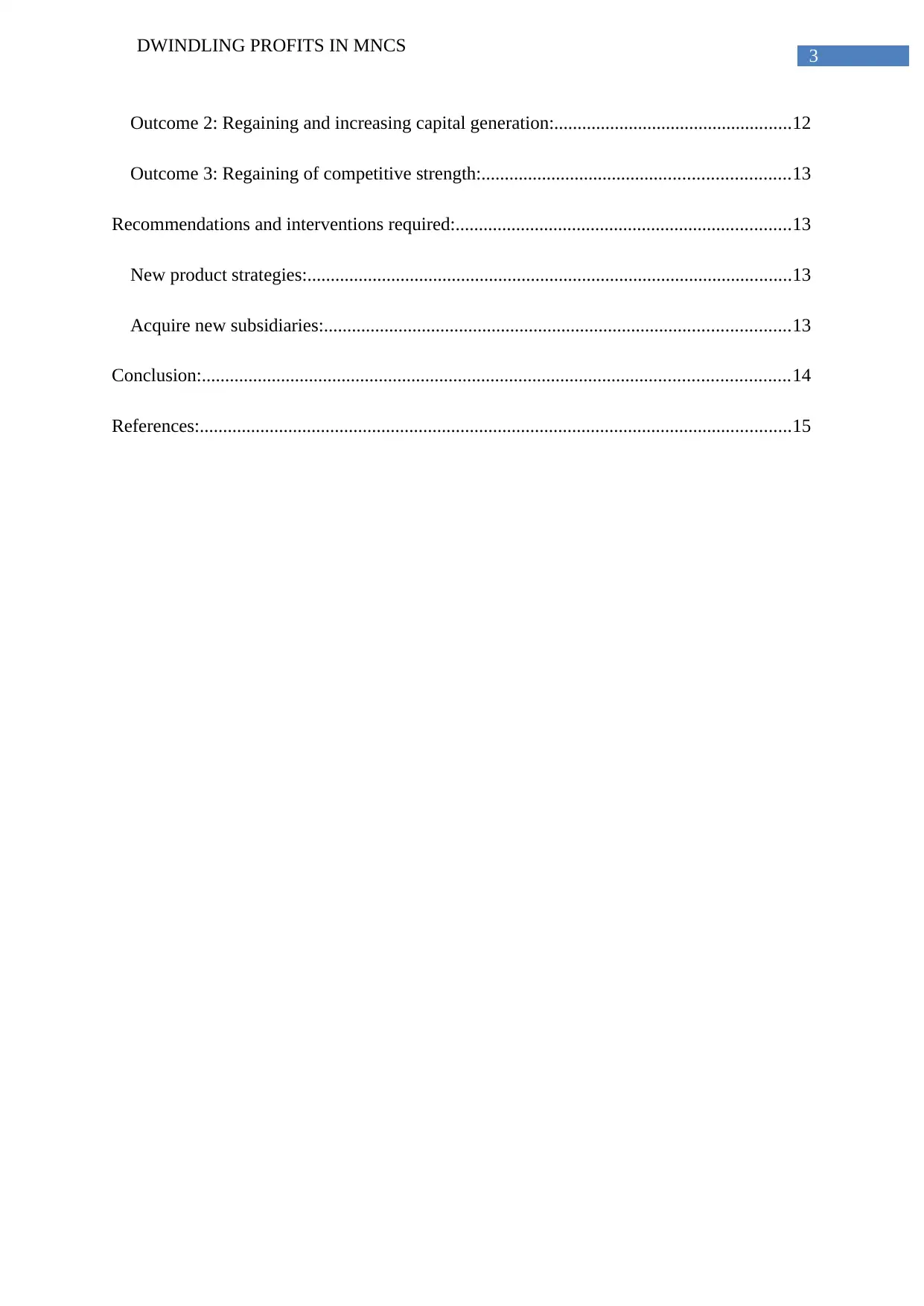
3
DWINDLING PROFITS IN MNCS
Outcome 2: Regaining and increasing capital generation:...................................................12
Outcome 3: Regaining of competitive strength:..................................................................13
Recommendations and interventions required:........................................................................13
New product strategies:........................................................................................................13
Acquire new subsidiaries:....................................................................................................13
Conclusion:..............................................................................................................................14
References:...............................................................................................................................15
DWINDLING PROFITS IN MNCS
Outcome 2: Regaining and increasing capital generation:...................................................12
Outcome 3: Regaining of competitive strength:..................................................................13
Recommendations and interventions required:........................................................................13
New product strategies:........................................................................................................13
Acquire new subsidiaries:....................................................................................................13
Conclusion:..............................................................................................................................14
References:...............................................................................................................................15
Paraphrase This Document
Need a fresh take? Get an instant paraphrase of this document with our AI Paraphraser
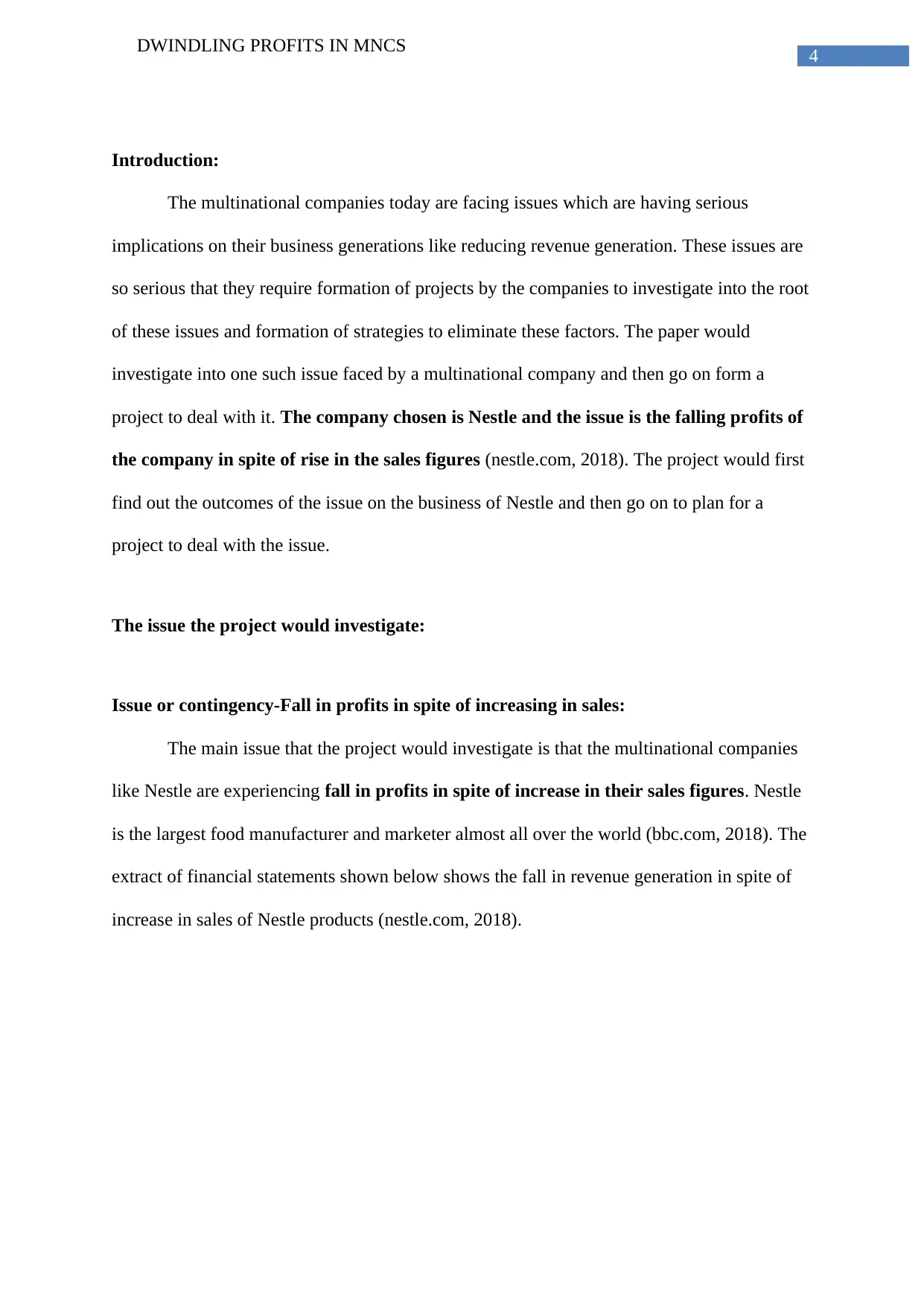
4
DWINDLING PROFITS IN MNCS
Introduction:
The multinational companies today are facing issues which are having serious
implications on their business generations like reducing revenue generation. These issues are
so serious that they require formation of projects by the companies to investigate into the root
of these issues and formation of strategies to eliminate these factors. The paper would
investigate into one such issue faced by a multinational company and then go on form a
project to deal with it. The company chosen is Nestle and the issue is the falling profits of
the company in spite of rise in the sales figures (nestle.com, 2018). The project would first
find out the outcomes of the issue on the business of Nestle and then go on to plan for a
project to deal with the issue.
The issue the project would investigate:
Issue or contingency-Fall in profits in spite of increasing in sales:
The main issue that the project would investigate is that the multinational companies
like Nestle are experiencing fall in profits in spite of increase in their sales figures. Nestle
is the largest food manufacturer and marketer almost all over the world (bbc.com, 2018). The
extract of financial statements shown below shows the fall in revenue generation in spite of
increase in sales of Nestle products (nestle.com, 2018).
DWINDLING PROFITS IN MNCS
Introduction:
The multinational companies today are facing issues which are having serious
implications on their business generations like reducing revenue generation. These issues are
so serious that they require formation of projects by the companies to investigate into the root
of these issues and formation of strategies to eliminate these factors. The paper would
investigate into one such issue faced by a multinational company and then go on form a
project to deal with it. The company chosen is Nestle and the issue is the falling profits of
the company in spite of rise in the sales figures (nestle.com, 2018). The project would first
find out the outcomes of the issue on the business of Nestle and then go on to plan for a
project to deal with the issue.
The issue the project would investigate:
Issue or contingency-Fall in profits in spite of increasing in sales:
The main issue that the project would investigate is that the multinational companies
like Nestle are experiencing fall in profits in spite of increase in their sales figures. Nestle
is the largest food manufacturer and marketer almost all over the world (bbc.com, 2018). The
extract of financial statements shown below shows the fall in revenue generation in spite of
increase in sales of Nestle products (nestle.com, 2018).
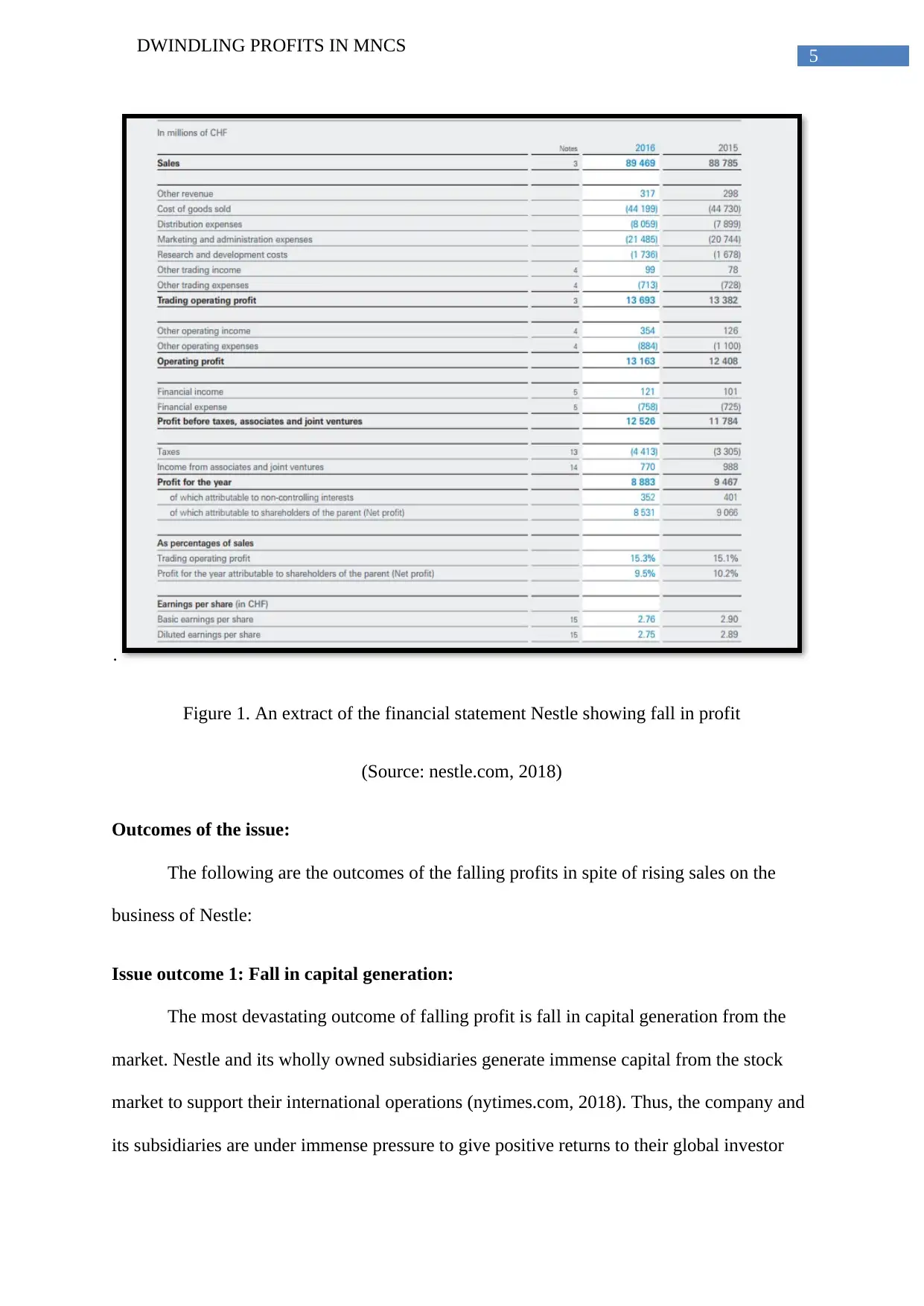
5
DWINDLING PROFITS IN MNCS
.
Figure 1. An extract of the financial statement Nestle showing fall in profit
(Source: nestle.com, 2018)
Outcomes of the issue:
The following are the outcomes of the falling profits in spite of rising sales on the
business of Nestle:
Issue outcome 1: Fall in capital generation:
The most devastating outcome of falling profit is fall in capital generation from the
market. Nestle and its wholly owned subsidiaries generate immense capital from the stock
market to support their international operations (nytimes.com, 2018). Thus, the company and
its subsidiaries are under immense pressure to give positive returns to their global investor
DWINDLING PROFITS IN MNCS
.
Figure 1. An extract of the financial statement Nestle showing fall in profit
(Source: nestle.com, 2018)
Outcomes of the issue:
The following are the outcomes of the falling profits in spite of rising sales on the
business of Nestle:
Issue outcome 1: Fall in capital generation:
The most devastating outcome of falling profit is fall in capital generation from the
market. Nestle and its wholly owned subsidiaries generate immense capital from the stock
market to support their international operations (nytimes.com, 2018). Thus, the company and
its subsidiaries are under immense pressure to give positive returns to their global investor
⊘ This is a preview!⊘
Do you want full access?
Subscribe today to unlock all pages.

Trusted by 1+ million students worldwide
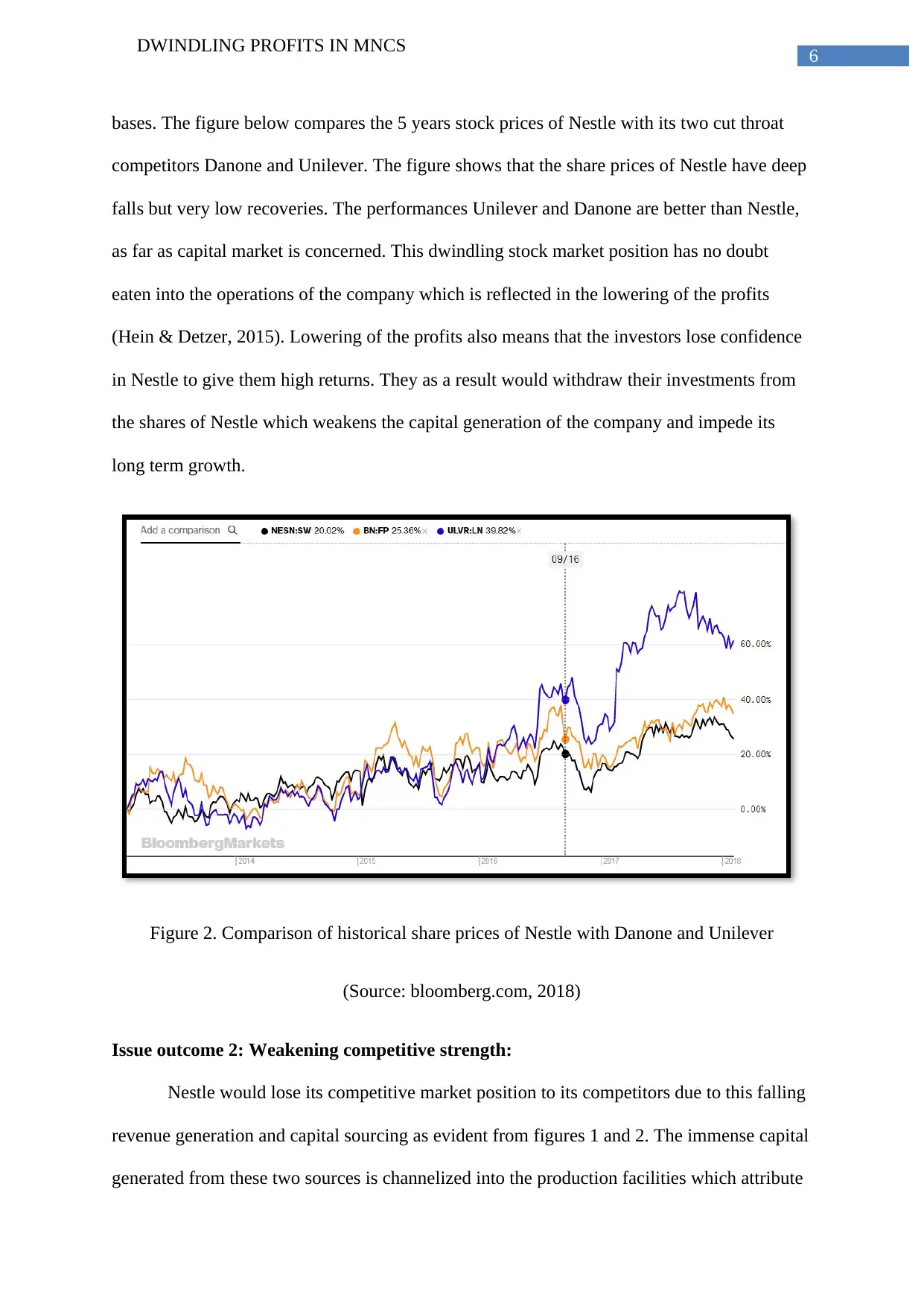
6
DWINDLING PROFITS IN MNCS
bases. The figure below compares the 5 years stock prices of Nestle with its two cut throat
competitors Danone and Unilever. The figure shows that the share prices of Nestle have deep
falls but very low recoveries. The performances Unilever and Danone are better than Nestle,
as far as capital market is concerned. This dwindling stock market position has no doubt
eaten into the operations of the company which is reflected in the lowering of the profits
(Hein & Detzer, 2015). Lowering of the profits also means that the investors lose confidence
in Nestle to give them high returns. They as a result would withdraw their investments from
the shares of Nestle which weakens the capital generation of the company and impede its
long term growth.
Figure 2. Comparison of historical share prices of Nestle with Danone and Unilever
(Source: bloomberg.com, 2018)
Issue outcome 2: Weakening competitive strength:
Nestle would lose its competitive market position to its competitors due to this falling
revenue generation and capital sourcing as evident from figures 1 and 2. The immense capital
generated from these two sources is channelized into the production facilities which attribute
DWINDLING PROFITS IN MNCS
bases. The figure below compares the 5 years stock prices of Nestle with its two cut throat
competitors Danone and Unilever. The figure shows that the share prices of Nestle have deep
falls but very low recoveries. The performances Unilever and Danone are better than Nestle,
as far as capital market is concerned. This dwindling stock market position has no doubt
eaten into the operations of the company which is reflected in the lowering of the profits
(Hein & Detzer, 2015). Lowering of the profits also means that the investors lose confidence
in Nestle to give them high returns. They as a result would withdraw their investments from
the shares of Nestle which weakens the capital generation of the company and impede its
long term growth.
Figure 2. Comparison of historical share prices of Nestle with Danone and Unilever
(Source: bloomberg.com, 2018)
Issue outcome 2: Weakening competitive strength:
Nestle would lose its competitive market position to its competitors due to this falling
revenue generation and capital sourcing as evident from figures 1 and 2. The immense capital
generated from these two sources is channelized into the production facilities which attribute
Paraphrase This Document
Need a fresh take? Get an instant paraphrase of this document with our AI Paraphraser
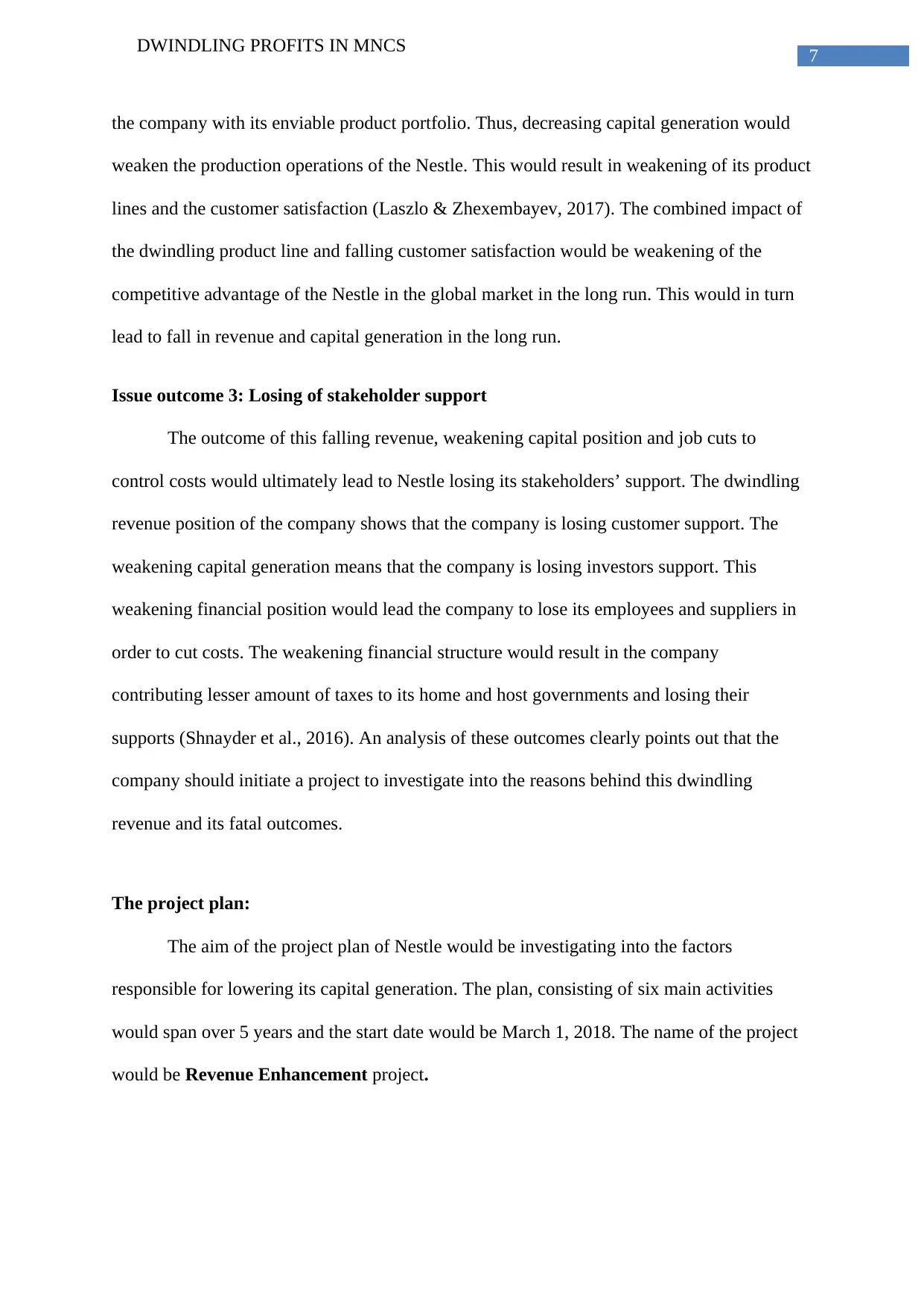
7
DWINDLING PROFITS IN MNCS
the company with its enviable product portfolio. Thus, decreasing capital generation would
weaken the production operations of the Nestle. This would result in weakening of its product
lines and the customer satisfaction (Laszlo & Zhexembayev, 2017). The combined impact of
the dwindling product line and falling customer satisfaction would be weakening of the
competitive advantage of the Nestle in the global market in the long run. This would in turn
lead to fall in revenue and capital generation in the long run.
Issue outcome 3: Losing of stakeholder support
The outcome of this falling revenue, weakening capital position and job cuts to
control costs would ultimately lead to Nestle losing its stakeholders’ support. The dwindling
revenue position of the company shows that the company is losing customer support. The
weakening capital generation means that the company is losing investors support. This
weakening financial position would lead the company to lose its employees and suppliers in
order to cut costs. The weakening financial structure would result in the company
contributing lesser amount of taxes to its home and host governments and losing their
supports (Shnayder et al., 2016). An analysis of these outcomes clearly points out that the
company should initiate a project to investigate into the reasons behind this dwindling
revenue and its fatal outcomes.
The project plan:
The aim of the project plan of Nestle would be investigating into the factors
responsible for lowering its capital generation. The plan, consisting of six main activities
would span over 5 years and the start date would be March 1, 2018. The name of the project
would be Revenue Enhancement project.
DWINDLING PROFITS IN MNCS
the company with its enviable product portfolio. Thus, decreasing capital generation would
weaken the production operations of the Nestle. This would result in weakening of its product
lines and the customer satisfaction (Laszlo & Zhexembayev, 2017). The combined impact of
the dwindling product line and falling customer satisfaction would be weakening of the
competitive advantage of the Nestle in the global market in the long run. This would in turn
lead to fall in revenue and capital generation in the long run.
Issue outcome 3: Losing of stakeholder support
The outcome of this falling revenue, weakening capital position and job cuts to
control costs would ultimately lead to Nestle losing its stakeholders’ support. The dwindling
revenue position of the company shows that the company is losing customer support. The
weakening capital generation means that the company is losing investors support. This
weakening financial position would lead the company to lose its employees and suppliers in
order to cut costs. The weakening financial structure would result in the company
contributing lesser amount of taxes to its home and host governments and losing their
supports (Shnayder et al., 2016). An analysis of these outcomes clearly points out that the
company should initiate a project to investigate into the reasons behind this dwindling
revenue and its fatal outcomes.
The project plan:
The aim of the project plan of Nestle would be investigating into the factors
responsible for lowering its capital generation. The plan, consisting of six main activities
would span over 5 years and the start date would be March 1, 2018. The name of the project
would be Revenue Enhancement project.
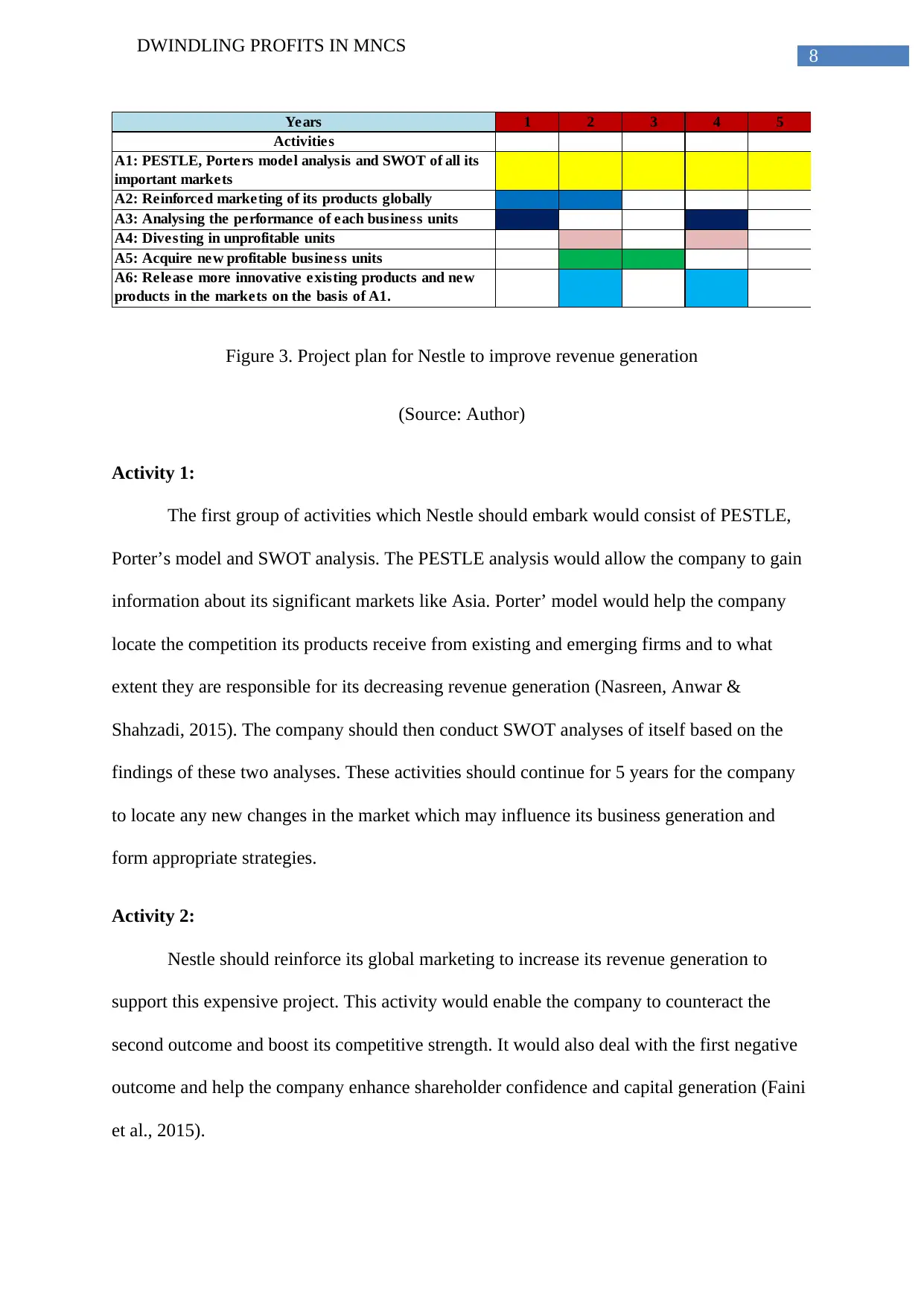
8
DWINDLING PROFITS IN MNCS
Years 1 2 3 4 5
Activities
A1: PESTLE, Porters model analysis and SWOT of all its
important markets
A2: Reinforced marketing of its products globally
A3: Analysing the performance of each business units
A4: Divesting in unprofitable units
A5: Acquire new profitable business units
A6: Release more innovative existing products and new
products in the markets on the basis of A1.
Figure 3. Project plan for Nestle to improve revenue generation
(Source: Author)
Activity 1:
The first group of activities which Nestle should embark would consist of PESTLE,
Porter’s model and SWOT analysis. The PESTLE analysis would allow the company to gain
information about its significant markets like Asia. Porter’ model would help the company
locate the competition its products receive from existing and emerging firms and to what
extent they are responsible for its decreasing revenue generation (Nasreen, Anwar &
Shahzadi, 2015). The company should then conduct SWOT analyses of itself based on the
findings of these two analyses. These activities should continue for 5 years for the company
to locate any new changes in the market which may influence its business generation and
form appropriate strategies.
Activity 2:
Nestle should reinforce its global marketing to increase its revenue generation to
support this expensive project. This activity would enable the company to counteract the
second outcome and boost its competitive strength. It would also deal with the first negative
outcome and help the company enhance shareholder confidence and capital generation (Faini
et al., 2015).
DWINDLING PROFITS IN MNCS
Years 1 2 3 4 5
Activities
A1: PESTLE, Porters model analysis and SWOT of all its
important markets
A2: Reinforced marketing of its products globally
A3: Analysing the performance of each business units
A4: Divesting in unprofitable units
A5: Acquire new profitable business units
A6: Release more innovative existing products and new
products in the markets on the basis of A1.
Figure 3. Project plan for Nestle to improve revenue generation
(Source: Author)
Activity 1:
The first group of activities which Nestle should embark would consist of PESTLE,
Porter’s model and SWOT analysis. The PESTLE analysis would allow the company to gain
information about its significant markets like Asia. Porter’ model would help the company
locate the competition its products receive from existing and emerging firms and to what
extent they are responsible for its decreasing revenue generation (Nasreen, Anwar &
Shahzadi, 2015). The company should then conduct SWOT analyses of itself based on the
findings of these two analyses. These activities should continue for 5 years for the company
to locate any new changes in the market which may influence its business generation and
form appropriate strategies.
Activity 2:
Nestle should reinforce its global marketing to increase its revenue generation to
support this expensive project. This activity would enable the company to counteract the
second outcome and boost its competitive strength. It would also deal with the first negative
outcome and help the company enhance shareholder confidence and capital generation (Faini
et al., 2015).
⊘ This is a preview!⊘
Do you want full access?
Subscribe today to unlock all pages.

Trusted by 1+ million students worldwide
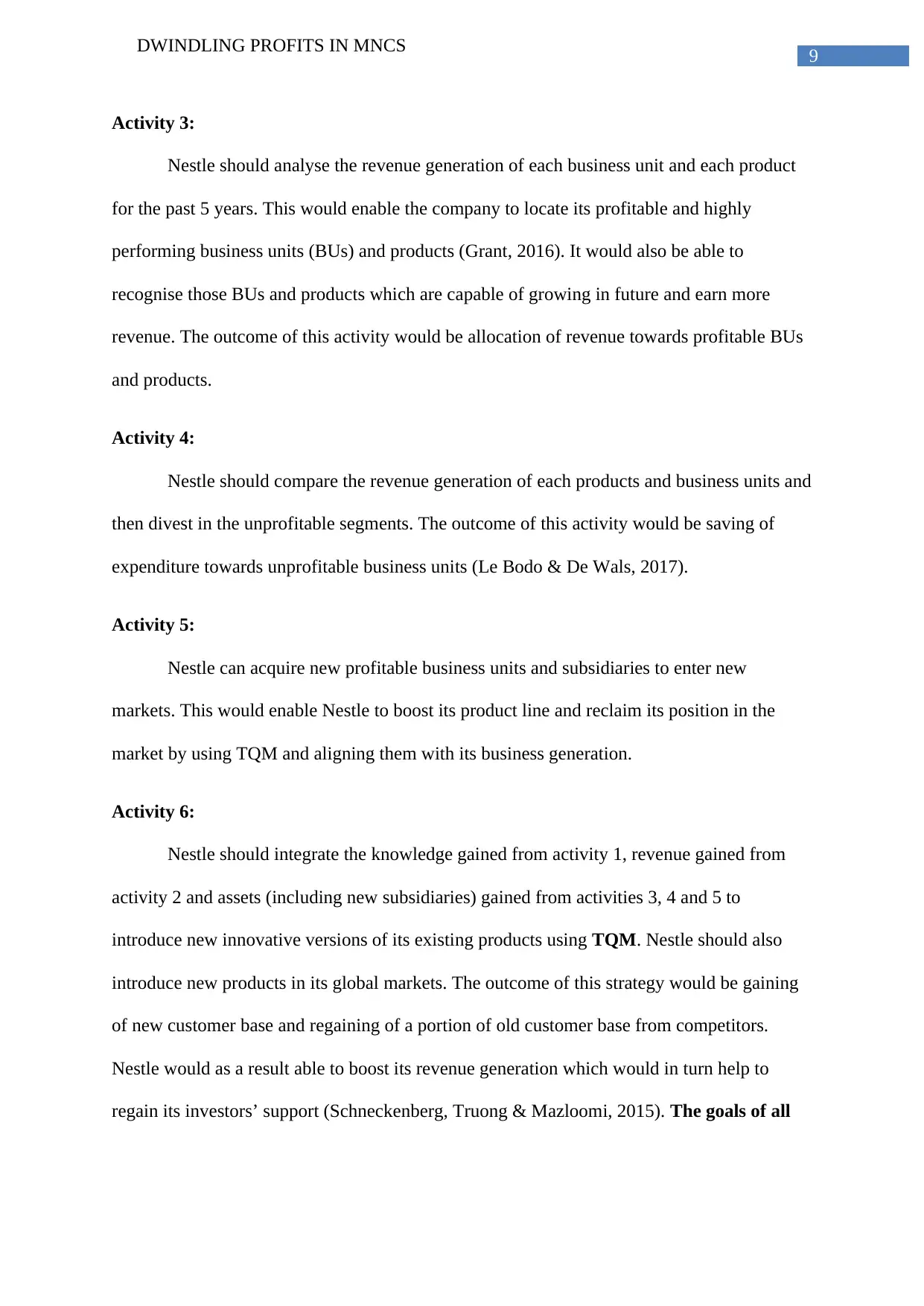
9
DWINDLING PROFITS IN MNCS
Activity 3:
Nestle should analyse the revenue generation of each business unit and each product
for the past 5 years. This would enable the company to locate its profitable and highly
performing business units (BUs) and products (Grant, 2016). It would also be able to
recognise those BUs and products which are capable of growing in future and earn more
revenue. The outcome of this activity would be allocation of revenue towards profitable BUs
and products.
Activity 4:
Nestle should compare the revenue generation of each products and business units and
then divest in the unprofitable segments. The outcome of this activity would be saving of
expenditure towards unprofitable business units (Le Bodo & De Wals, 2017).
Activity 5:
Nestle can acquire new profitable business units and subsidiaries to enter new
markets. This would enable Nestle to boost its product line and reclaim its position in the
market by using TQM and aligning them with its business generation.
Activity 6:
Nestle should integrate the knowledge gained from activity 1, revenue gained from
activity 2 and assets (including new subsidiaries) gained from activities 3, 4 and 5 to
introduce new innovative versions of its existing products using TQM. Nestle should also
introduce new products in its global markets. The outcome of this strategy would be gaining
of new customer base and regaining of a portion of old customer base from competitors.
Nestle would as a result able to boost its revenue generation which would in turn help to
regain its investors’ support (Schneckenberg, Truong & Mazloomi, 2015). The goals of all
DWINDLING PROFITS IN MNCS
Activity 3:
Nestle should analyse the revenue generation of each business unit and each product
for the past 5 years. This would enable the company to locate its profitable and highly
performing business units (BUs) and products (Grant, 2016). It would also be able to
recognise those BUs and products which are capable of growing in future and earn more
revenue. The outcome of this activity would be allocation of revenue towards profitable BUs
and products.
Activity 4:
Nestle should compare the revenue generation of each products and business units and
then divest in the unprofitable segments. The outcome of this activity would be saving of
expenditure towards unprofitable business units (Le Bodo & De Wals, 2017).
Activity 5:
Nestle can acquire new profitable business units and subsidiaries to enter new
markets. This would enable Nestle to boost its product line and reclaim its position in the
market by using TQM and aligning them with its business generation.
Activity 6:
Nestle should integrate the knowledge gained from activity 1, revenue gained from
activity 2 and assets (including new subsidiaries) gained from activities 3, 4 and 5 to
introduce new innovative versions of its existing products using TQM. Nestle should also
introduce new products in its global markets. The outcome of this strategy would be gaining
of new customer base and regaining of a portion of old customer base from competitors.
Nestle would as a result able to boost its revenue generation which would in turn help to
regain its investors’ support (Schneckenberg, Truong & Mazloomi, 2015). The goals of all
Paraphrase This Document
Need a fresh take? Get an instant paraphrase of this document with our AI Paraphraser
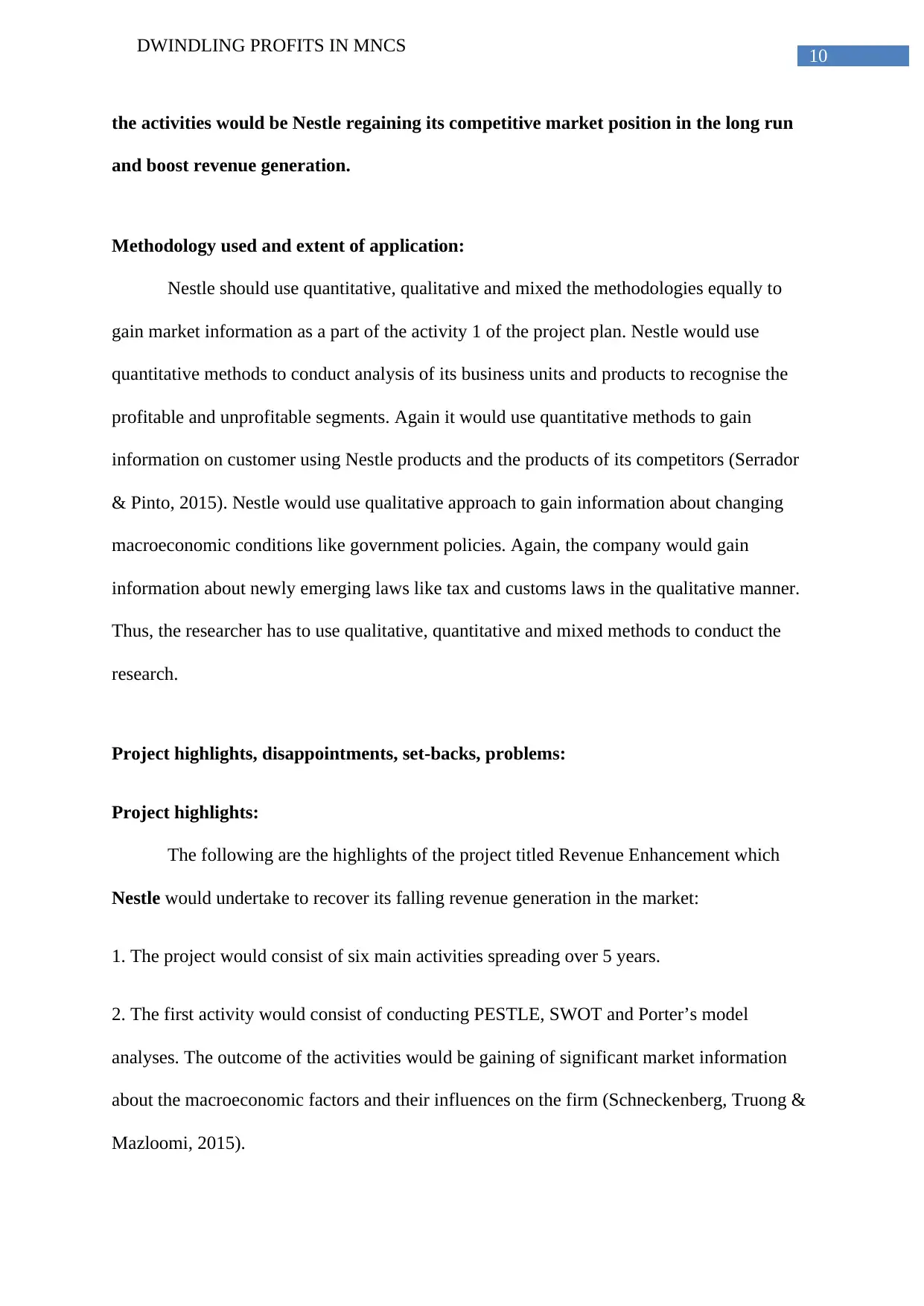
10
DWINDLING PROFITS IN MNCS
the activities would be Nestle regaining its competitive market position in the long run
and boost revenue generation.
Methodology used and extent of application:
Nestle should use quantitative, qualitative and mixed the methodologies equally to
gain market information as a part of the activity 1 of the project plan. Nestle would use
quantitative methods to conduct analysis of its business units and products to recognise the
profitable and unprofitable segments. Again it would use quantitative methods to gain
information on customer using Nestle products and the products of its competitors (Serrador
& Pinto, 2015). Nestle would use qualitative approach to gain information about changing
macroeconomic conditions like government policies. Again, the company would gain
information about newly emerging laws like tax and customs laws in the qualitative manner.
Thus, the researcher has to use qualitative, quantitative and mixed methods to conduct the
research.
Project highlights, disappointments, set-backs, problems:
Project highlights:
The following are the highlights of the project titled Revenue Enhancement which
Nestle would undertake to recover its falling revenue generation in the market:
1. The project would consist of six main activities spreading over 5 years.
2. The first activity would consist of conducting PESTLE, SWOT and Porter’s model
analyses. The outcome of the activities would be gaining of significant market information
about the macroeconomic factors and their influences on the firm (Schneckenberg, Truong &
Mazloomi, 2015).
DWINDLING PROFITS IN MNCS
the activities would be Nestle regaining its competitive market position in the long run
and boost revenue generation.
Methodology used and extent of application:
Nestle should use quantitative, qualitative and mixed the methodologies equally to
gain market information as a part of the activity 1 of the project plan. Nestle would use
quantitative methods to conduct analysis of its business units and products to recognise the
profitable and unprofitable segments. Again it would use quantitative methods to gain
information on customer using Nestle products and the products of its competitors (Serrador
& Pinto, 2015). Nestle would use qualitative approach to gain information about changing
macroeconomic conditions like government policies. Again, the company would gain
information about newly emerging laws like tax and customs laws in the qualitative manner.
Thus, the researcher has to use qualitative, quantitative and mixed methods to conduct the
research.
Project highlights, disappointments, set-backs, problems:
Project highlights:
The following are the highlights of the project titled Revenue Enhancement which
Nestle would undertake to recover its falling revenue generation in the market:
1. The project would consist of six main activities spreading over 5 years.
2. The first activity would consist of conducting PESTLE, SWOT and Porter’s model
analyses. The outcome of the activities would be gaining of significant market information
about the macroeconomic factors and their influences on the firm (Schneckenberg, Truong &
Mazloomi, 2015).
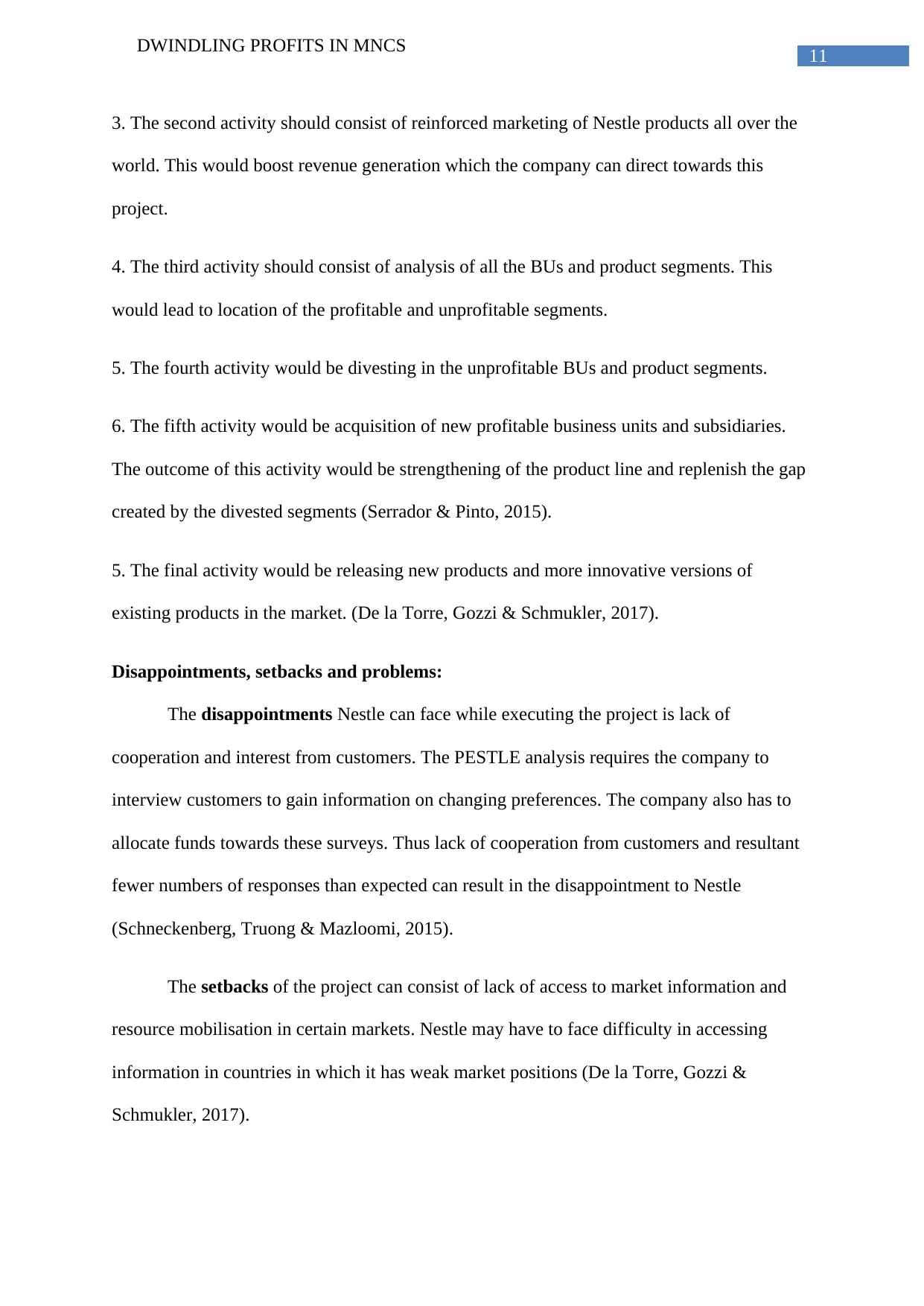
11
DWINDLING PROFITS IN MNCS
3. The second activity should consist of reinforced marketing of Nestle products all over the
world. This would boost revenue generation which the company can direct towards this
project.
4. The third activity should consist of analysis of all the BUs and product segments. This
would lead to location of the profitable and unprofitable segments.
5. The fourth activity would be divesting in the unprofitable BUs and product segments.
6. The fifth activity would be acquisition of new profitable business units and subsidiaries.
The outcome of this activity would be strengthening of the product line and replenish the gap
created by the divested segments (Serrador & Pinto, 2015).
5. The final activity would be releasing new products and more innovative versions of
existing products in the market. (De la Torre, Gozzi & Schmukler, 2017).
Disappointments, setbacks and problems:
The disappointments Nestle can face while executing the project is lack of
cooperation and interest from customers. The PESTLE analysis requires the company to
interview customers to gain information on changing preferences. The company also has to
allocate funds towards these surveys. Thus lack of cooperation from customers and resultant
fewer numbers of responses than expected can result in the disappointment to Nestle
(Schneckenberg, Truong & Mazloomi, 2015).
The setbacks of the project can consist of lack of access to market information and
resource mobilisation in certain markets. Nestle may have to face difficulty in accessing
information in countries in which it has weak market positions (De la Torre, Gozzi &
Schmukler, 2017).
DWINDLING PROFITS IN MNCS
3. The second activity should consist of reinforced marketing of Nestle products all over the
world. This would boost revenue generation which the company can direct towards this
project.
4. The third activity should consist of analysis of all the BUs and product segments. This
would lead to location of the profitable and unprofitable segments.
5. The fourth activity would be divesting in the unprofitable BUs and product segments.
6. The fifth activity would be acquisition of new profitable business units and subsidiaries.
The outcome of this activity would be strengthening of the product line and replenish the gap
created by the divested segments (Serrador & Pinto, 2015).
5. The final activity would be releasing new products and more innovative versions of
existing products in the market. (De la Torre, Gozzi & Schmukler, 2017).
Disappointments, setbacks and problems:
The disappointments Nestle can face while executing the project is lack of
cooperation and interest from customers. The PESTLE analysis requires the company to
interview customers to gain information on changing preferences. The company also has to
allocate funds towards these surveys. Thus lack of cooperation from customers and resultant
fewer numbers of responses than expected can result in the disappointment to Nestle
(Schneckenberg, Truong & Mazloomi, 2015).
The setbacks of the project can consist of lack of access to market information and
resource mobilisation in certain markets. Nestle may have to face difficulty in accessing
information in countries in which it has weak market positions (De la Torre, Gozzi &
Schmukler, 2017).
⊘ This is a preview!⊘
Do you want full access?
Subscribe today to unlock all pages.

Trusted by 1+ million students worldwide
1 out of 18
Your All-in-One AI-Powered Toolkit for Academic Success.
+13062052269
info@desklib.com
Available 24*7 on WhatsApp / Email
![[object Object]](/_next/static/media/star-bottom.7253800d.svg)
Unlock your academic potential
Copyright © 2020–2025 A2Z Services. All Rights Reserved. Developed and managed by ZUCOL.


